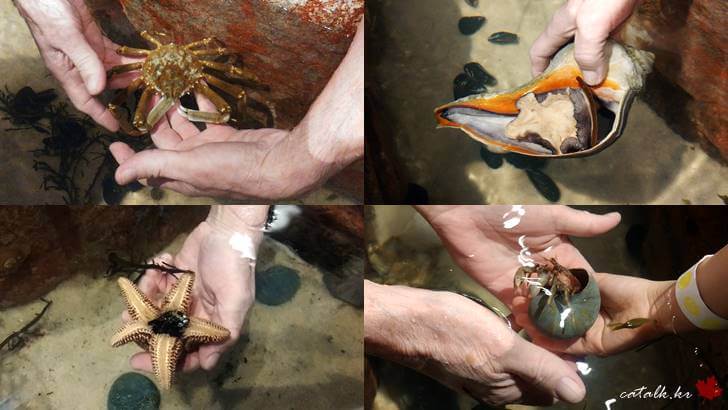Marine life lived in the St. Lawrence River
the Aquatarium of City of Brockville
We went to Aquatarium in Brockville, Ontario. The Aquatarium is a non-profit organization. You may discover the diverse wildlife of 1000 Islands of Ontario region, explore the area’s unique history and culture, learn about the economics of the St. Lawrence River, and have fun with recreational experiences. It was a very special experience for us to see and touched the the marine animals on the sea water tank that re-creation of the ancient Champlain Sea. The Champlain Sea is a body of saline to brackish water 55,000 km2 that occupied the depressed land of the St. Lawrence Lowland between Québec City, Québec and Brockville, Ontario, and extended up the Ottawa River Valley during the late glacial period 12,000 to 10,000 years ago. Below are the marine life we touched and saw with a staff.

Spider Crab
This long-legged crustacean is in fact a crab and not a spider as its name suggests. They have poor eyesight but they have sensitive tasting and sensing organ on the end of each walking leg.
Blue Mussel
Some predators of mussels wait until the mussel is forced to open its valves to breathe. The predator then pushes the mussel’s siphon into the gap, wedging the mussel open so it can be eaten.
Frilled Sea Anemone
The tubular body of this sea anemone is topped with a ring of hundreds of tiny feathery tentacles, with a mouth in the centre.

Forbes Sea Star
Did you know that Sea Stars used to be called Starfish? Scientists now call them Sea Stars because they are not fish – they belong to a family of invertebrates called Echinoderms.
Purple-Spined Sea Urchin
Sea urchins have a unique structure called Aristotle’s lantern. This structure is made of five hard plates that move together like a beak. They use this beak like structure to scrape rocks clean of algae.
Channeled Whelk
Whelks are subtidal animals, meaning they live only below the low tidemark in sandy or muddy bottoms because they cannot survive being exposed to the air. The Channeled Whelk can grow up to 12 inches in length!
Knobbed Whelk
The Knobbed Whelk feeds on clams, oysters, mussels and other bivalves. Predators that feed on Knobbed Whelk include crabs, sea stars and urchins.
Periwinkle
The periwinkle grazes on detritus and microorganisms. It also feeds on green seaweeds such as sea lettuce. Egg laying is timed to coincide with the spring tide.



